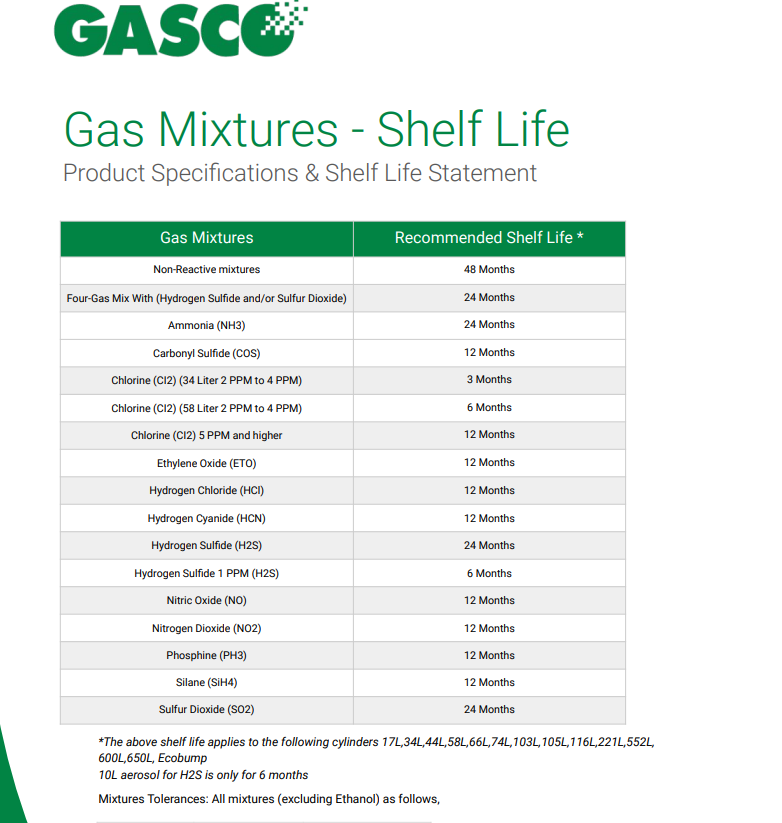 Loading... Please wait...
Loading... Please wait... Loading... Please wait...
Loading... Please wait...
You should assume that all material on the Site is protected by copyright unless otherwise noted and may not be used.
Materials, Products, Pictures, Code, Part Numbers, Pricing and all other content displayed on the Site are either the property of, or used with permission by, Cal Gas Direct Incorporated. The use of these materials by you, or anyone else authorized by you, is prohibited unless specifically permitted by these Terms and Conditions or specific permission is provided elsewhere on the Site.
Any unauthorized Materials, Products, Pictures, Code, Part Numbers, Pricing and all other content displayed on the Site may violate copyright laws, trademark laws, the laws of privacy and publicity, and civil and criminal statutes.

https://www.calgasdirect.com/terms-of-use/

Non-Reactive Gases: 48 Months
(Acetylene, Argon, Benzene, Butane, Butadiene, Carbon Dioxide, Carbon Monoxide, Ethane, Ethanol, Ethylene, Freon, Helium, Hexane, Hydrogen, Isobutane, Isobutylene, Methane, Methyl Chloride, Methyl Mercaptan, Nitrogen, Nitrous Oxide, Oxygen, Pentane, Propane, Propylene, Toluene )
Four-Gas Calibration Mixtures: 15 Months
With (Hydrogen Sulfide and/or Sulfur Dioxide)
Individual Gas Shelf Life:
Ammonia (NH3) 24 Months
Carbonyl Sulfide (COS) 12 Months
Chlorine (CI2) (34 Liter 4, 3, 2 PPM) 3 Months
Chlorine (CI2) (58 Liter 4, 3, 2 PPM) 6 Months
Chlorine (CI2) 1 PPM 3 Months
Chlorine (CI2) 5 PPM and higher 12 Months
Ethylene Oxide (ETO) 12 Months
Hydrogen Chloride (HCl) 12 Months
Hydrogen Cyanide (HCN) 12 Months
Hydrogen Sulfide (H2S) 24 Months
Hydrogen Sulfide 1 PPM (H2S) 6 Months
Nitric Oxide (NO) 12 Months
Nitrogen Dioxide (NO2) 12 Months
Phosphine (PH3) 12 Months
Silane (SiH4) 12 Months
Sulfur Dioxide (SO2) 24 Months
Actual volume and PSI in the cylinder may fluctuate based on numerous conditions
Blend Tolerance:
We offer Certified Standards Blend Tolerance is +/- 10%
Certified Standards, sometimes referred to as working
standards, are analyzed calibration mixtures used routinely
in science and industry. For the majority of applications,
the tolerance of a Certified Standard is acceptable
Explanation of the Tolerances
Gasco has two tolerances associated with all our mixture
grades. First is the Blend Tolerance or Preparation tolerance. This is
the minimum acceptable uncertainty associated with the
actual production of the blend. These uncertainties are
accumulated during the manufacturing process because of
equipment used in production, and due to the physical
properties of the gases. Second is the Analytical Result or
Certification tolerance, which is the minimum acceptable
uncertainty, associated with the analysis of the blend. This
uncertainty is accumulated throughout the analytical procedure and includes instrument and calibration uncertainties.
For most applications, the Analytical tolerance is of greater importance than the blend tolerance because it represents the range in which the true or actual concentration may be in relation to the analytical concentration. For some applications, such as those that require an upper or lower range of concentration that cannot be exceeded, the Blend / preparation tolerance becomes equally if not more important.
Blend Tolerance +/- 10%
Analytical Result +/- 5%
Traceability in Calibration Gas Mixtures
Gasco offers calibration gas mixtures with established
and defined traceability to NIST or to an equivalent
national measurement institute. Each traceable mixture is
accompanied by full documentation in the form of a
Certificate of Analysis (COA), designed in compliance
with applicable guidelines.